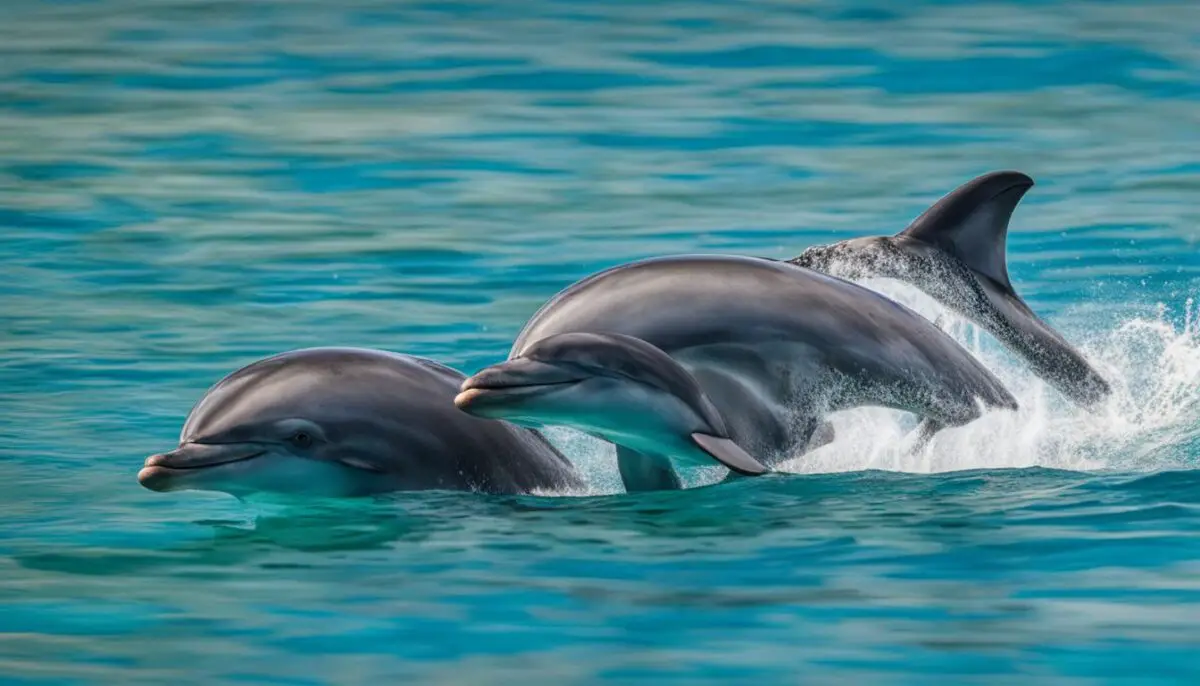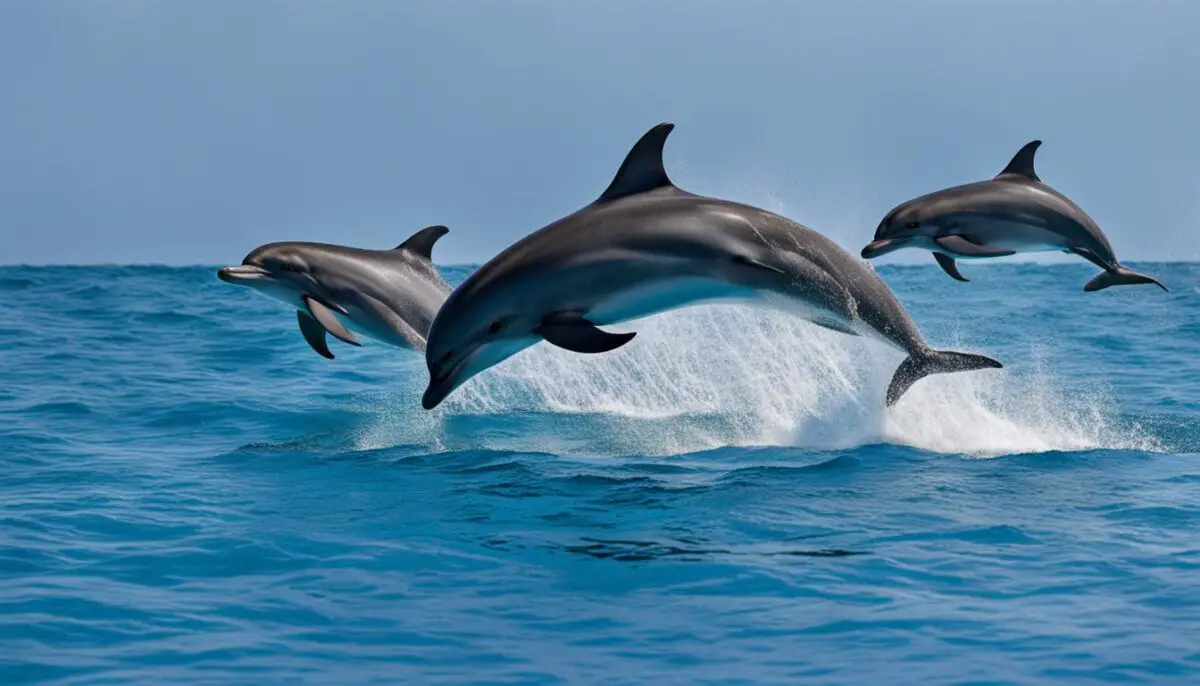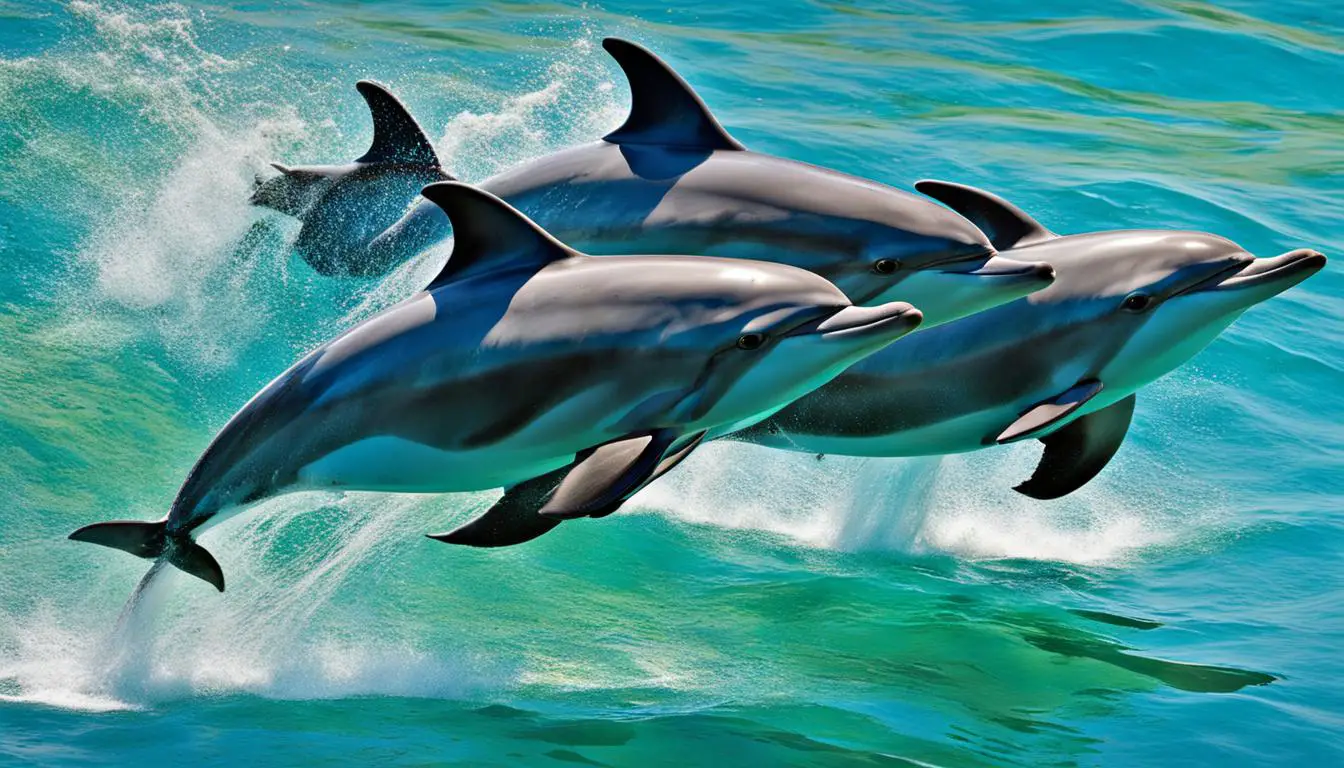When it comes to the fascinating world of dolphins, their mating habits and reproductive behaviors are a topic of great intrigue. Unlike many other animals, dolphins do not have a specific mating season. They have the ability to mate throughout the year, displaying unique patterns and rituals that shed light on their breeding behavior and reproductive cycles.
During mating, dolphins engage in elaborate foreplay, with about 90% of their mating activity dedicated to this playful courtship. However, the act of intercourse itself lasts only a few seconds. Male dolphins typically become sexually mature between the ages of 8 to 12 years, while females reach maturity a little earlier, between 5 to 10 years of age (Wells 1999).
Key Takeaways:
- Dolphins do not have a specific mating season and can mate throughout the year.
- Foreplay constitutes a significant portion of dolphins’ mating activity.
- Males become sexually mature between 8 to 12 years, while females reach maturity between 5 to 10 years.
Gender Differences and Reproductive Tract of Dolphins
Dolphins, like many marine mammals, exhibit interesting gender differences in their reproductive anatomy. These differences can be observed by looking at their genital slits. Let’s delve into the details:
Male Dolphins: Males possess two distinct genital slits – one for the penis and one for the anus. Their reproductive organs are specifically designed to maintain a streamlined shape, ensuring efficient swimming. To achieve this, male dolphins have their penis and testicles packed inside their body. This internal arrangement allows them to minimize drag and move swiftly through the water.
In addition, male dolphins have an intricate network of blood vessels that help regulate the temperature of their testicles. This network keeps their testicles cooler than their core body temperature, which is crucial for sperm production and viability (Harrison 1948).
Female Dolphins: In contrast to males, females have a single genital slit that houses both the vagina and anus. This genital configuration is different from most other mammals. To determine the gender of a dolphin, researchers primarily rely on observation of their genitals or the presence of a baby swimming close to an adult presumed to be female.

“Dolphins engage in a variety of amorous activities as part of their courtship behavior.” – Samuels, 1989
These amorous activities and courtship behaviors of dolphins play a crucial role in their social interactions and relationships. It helps individuals bond and strengthen their social connections within their pods, leading to a cohesive and cooperative community. Understanding these mating habits provides valuable insights into the complex behavior and social dynamics of dolphins.
Courtship Behaviors and Mating Rituals
Dolphins exhibit a range of courtship behaviors to attract potential mates. These behaviors may include displays of agility, vocalizations, and physical contact. Male dolphins often compete for the attention of females and may engage in aggressive interactions with rival males to establish dominance.
The courtship process helps dolphins assess potential partners and ensure successful reproduction. It allows them to demonstrate their physical fitness, intelligence, and social standing within the pod.
| Courtship Behavior | Description |
|---|---|
| Vocalizations | Dolphins produce a wide range of clicks, whistles, and other sounds to communicate with potential mates. |
| Leaping and Flipper Slap | Males may leap out of the water or slap their flippers on the surface to attract female attention and demonstrate their physical prowess. |
| Gift-Giving | In some cases, male dolphins may present objects such as seashells or fish to females as a form of courtship behavior. |
| Body Contact and Petting | Dolphins may engage in physical contact, such as rubbing or petting, as a way to strengthen social bonds and attraction. |
These courtship behaviors are essential in establishing connections and initiating mating opportunities among dolphins. By studying these behaviors, researchers gain a deeper understanding of the complexities of dolphin courtship and social dynamics.
Pregnancy and Reproductive Cycle of Dolphins
Dolphin reproduction is a fascinating and complex process. Let’s delve into the details of dolphin pregnancy, the reproductive cycle, and the gestation period of these incredible marine mammals.
Dolphin pregnancies can last between nine and seventeen months, depending on the species. During this time, the developing baby dolphin, known as a calf, puts pressure on the organs of the mother dolphin. This pressure causes the tail fluke and dorsal fin to fold over, allowing the mother to swim more efficiently despite the added weight.
Female dolphins give birth to their calves tail first, which helps prevent drowning during delivery. The umbilical cord breaks naturally during the birthing process, allowing the calf to become independent from its mother.
After giving birth, female dolphins produce milk in their mammary glands to nourish their calves. Dolphin calves nurse for a minimum of one to two years, receiving vital nutrients for their growth and development. In some instances, nursing can last up to four and a half years, ensuring the calf’s well-being and survival in their marine environment (Wells 1999).
“The reproductive cycle of dolphins involves a significant investment of time and resources for the female, highlighting their dedication and commitment to their offspring.”
The reproductive cycle of dolphins demonstrates the extraordinary abilities of female dolphins to reproduce and care for their young. By understanding the intricacies of dolphin reproduction, researchers and conservationists can develop effective strategies to protect these magnificent creatures and their vulnerable populations.
Dolphin Pregnancy and the Gestation Period by Species
| Dolphin Species | Pregnancy Duration |
|---|---|
| Bottlenose Dolphin | 12 to 14 months |
| Killer Whale (Orca) | 15 to 18 months |
| Spinner Dolphin | 10 to 11 months |
| Common Dolphin | 9 to 11 months |
| Risso’s Dolphin | 13 to 14 months |
Table: Dolphin pregnancy duration varies across different species.
As seen in the table above, the gestation period of dolphins varies depending on the species. Bottlenose dolphins have a pregnancy duration of approximately 12 to 14 months, while killer whales, also known as orcas, have a longer gestation period of 15 to 18 months. Spinner dolphins, common dolphins, and Risso’s dolphins have shorter pregnancy durations ranging from 9 to 14 months (Wells 1999).

Image: Illustration of a dolphin pair depicting the reproductive cycle of dolphins.
Social Groupings and Family Structure of Dolphins
Dolphins are highly social creatures, forming intricate groupings and exhibiting a complex family structure. These social dynamics play a significant role in their lives, including their mating habits and reproductive behaviors.
Maternity Pods: Dolphins form maternity pods, which consist of females and their calves. These pods provide a supportive environment for mother dolphins, allowing them to assist in the birthing process and help rear their young. The presence of other females in the pod fosters a sense of cooperation and caregiving, ensuring the survival and well-being of the calves.
Male Involvement: Adult male dolphins generally do not actively participate in the rearing of their young. They tend to stay separate from female pods except during mating season when their focus shifts to reproductive activities. Male dolphins form alliances and engage in competitive behaviors to gain access to mating opportunities.
Juvenile Pods: Once the young dolphins reach adolescence and become independent from their mothers, they form separate groupings known as juvenile pods. These pods allow young dolphins to socialize, learn essential skills, and establish relationships among their peers. It is during this stage that they further develop their social behaviors and adapt to life outside their maternal pod.
Female-Focused Groups: Female dolphins tend to stay in groups throughout their lives, forming long-lasting social bonds. These groups often consist of several generations of females, creating a family-like structure. The presence of older and more experienced females provides guidance and support for younger females as they navigate their lives.
Male-Male Alliances: On the other hand, male dolphins leave their maternal groups when they reach sexual maturity and form alliances with other young males. These alliances serve various purposes, including increasing their chances of successful mating and providing protection against potential threats. Male dolphins establish dominance hierarchies within their alliances through displays of aggression, such as head-butting and vocalization.
To better understand the social groupings and family structure of dolphins, let’s take a closer look at a comparison table:
| Aspect | Maternity Pods | Male Alliances |
|---|---|---|
| Composition | Females with calves | Young males |
| Role | Birthing assistance, rearing young | Mating, protection |
| Longevity | Long-term, multiple generations | Seasonal and temporary |
| Activities | Cooperation, caregiving | Competitive behaviors |
This table highlights the distinct characteristics of maternity pods and male alliances, shedding light on the social dynamics and roles within the dolphin community.
As we delve deeper into the fascinating world of dolphins, it becomes apparent that their social groupings and family structures are integral to their survival, reproduction, and overall well-being. These complex relationships provide insights into their mating habits, social behaviors, and the interconnectedness of their marine communities.
Conclusion
Dolphins exhibit unique mating behaviors and reproductive patterns. Unlike many other animals, they mate throughout the year without a specific mating season. Their mating rituals involve extensive foreplay and brief intercourse, with males and females showcasing distinct courtship behaviors.
One fascinating aspect of dolphin reproduction is the presence of distinct reproductive tracts. Males have internal testicles to maintain their streamlined body shape, while females have a single genital slit housing the vagina and anus. Understanding these differences helps scientists differentiate between males and females and study their respective roles in the mating process.
Pregnancy in dolphins lasts for several months, with the gestation period varying depending on the dolphin species. Females give birth to their calves tail first and nurse them for an extended period, typically one to two years. This nurturing bond helps ensure the young dolphins’ survival and reinforces the complex family structure within dolphin social groups.
Dolphins form social groupings with females staying in groups and creating families that consist of multiple generations of females. In contrast, males form separate alliances once they reach sexual maturity. This intricate social structure contributes to the overall conservation efforts of dolphins, as scientists and conservationists work to protect these magnificent marine mammals.
FAQ
Do dolphins have a specific mating season?
No, dolphins do not have a specific mating season and can mate throughout the year.
How long does dolphin mating activity last?
Although dolphins engage in mating activity throughout the year, 90% of their mating activity is foreplay, while intercourse itself only takes seconds.
At what age do male and female dolphins become sexually mature?
Male dolphins become sexually mature between 8 to 12 years of age, while female dolphins become sexually mature a little sooner at around 5 to 10 years of age.
How can you determine the gender of dolphins?
Male and female dolphins have distinct genital slits. Males have two slits, one for the penis and one for the anus, while females have one genital slit housing the vagina and anus.
How do male dolphins keep their testicles cool?
Male dolphins have a network of blood vessels that cool their testicles to keep them below their core body temperature. Their penis and testicles are packed inside their body to maintain a streamlined shape for efficient swimming.
What amorous activities do dolphins engage in?
Dolphins engage in various amorous activities, including chasing each other, raking each other with their teeth, and lying on their sides when feeling amorous. They can have sex with the opposite gender, the same gender, or engage in masturbation with inanimate objects.
How long is a dolphin’s pregnancy?
Dolphin pregnancies can last between nine and seventeen months, depending on the species.
How do female dolphins give birth?
Female dolphins give birth to their calves tail first, and the umbilical cord breaks during delivery.
How long do dolphins nurse their calves?
Female dolphins produce milk in their mammary glands and nurse their calves for a minimum of one to two years, with some instances of nursing up to four and a half years.
What are the social groupings of dolphins?
Dolphins form social groupings, including maternity pods consisting of females with calves. Female dolphins assist in birth and play a role in rearing young dolphins.
What is the family structure of dolphins?
Female dolphins stay in groups and create families with several generations of females, while males leave the groups when they reach sexual maturity and form groups of young males.


